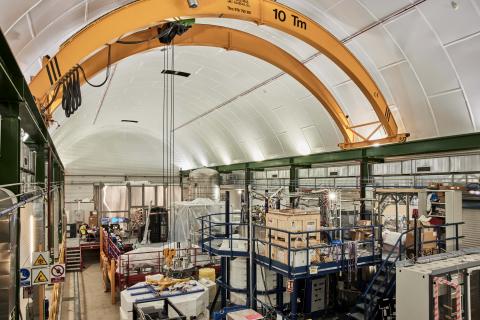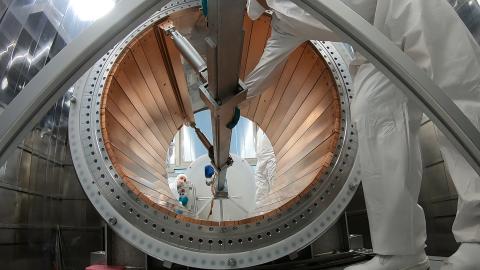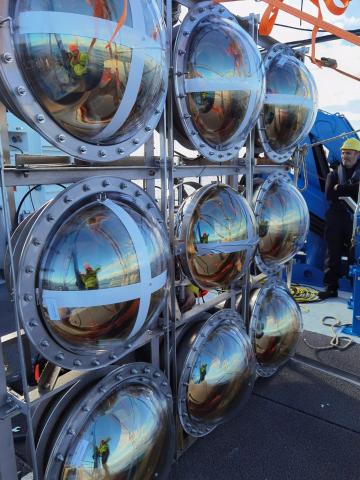



General information
-
Hosting OrganisationLaboratorio Subterráneo de Canfranc
-
AddressPaseo de los Ayerbe S/N 22880 – Canfranc-Estación
-
Contact Info:
-
Phone
-
Emailinfo@lsc-canfranc.es
Description
The LSC (Laboratorio Subterráneo de Canfranc), second largest deep underground scientific laboratory in Europe, is run by a Consortium between the Spanish Ministry of Science, Innovation and Universities, the Government of Aragon and the University of Zaragoza. The LSC is part of the Spanish network of ICTS (Unique Scientific and Technological Facilities). It offers to researchers, about 300 from all over the world, the opportunity to carry out cutting-edge science on physics, astrophysics as well as biology, geophysics and environmental science in its facilities of unique characteristics. The underground facilities at the LSC are located at 800 meters below ground and excavated between the Somport road tunnel and the old railway tunnel in Canfranc Estación, about 8 km on the Spain-France border. Their uniqueness opens the possibility to discover very rare phenomena.
Main equipment or Facilities
The LSC is a unique multidisciplinary scientific and technical facility with a surface area of 1600 m2 and a volume of 10,000 m3 in the underground laboratory equipped with an outstanding number of facilities. The main underground infrastructure, called LAB2400, is divided into Hall A, the largest experimental area with 600 m2, Hall B and C and services area.
To support the construction of the experiments in the LSC, there is a Radiopurity Service for ultralow level measurements. On one hand, LSC hosts several high purity Germanium detectors, leading the highest sensitivity in gamma detection worldwide (below 0.01 mB/kg). Additionally, LSC hosts two Inductive Coupled Plasma Mass Spectrometry (ICP-MS) facilities, the one placed in a clean room underground is leading the highest sensitivity worldwide (ppq sensitivity in Uranium). The underground laboratory also provides reduced background environments with radon-free air (1 mBq/m3) and five ISO6/ISO7 Cleanrooms. Among the production services, LSC provides ultrapure lead and copper, improved with the Copper Electroforming Facility.
Projects under Development
• ANAIS: Dark matter search based on looking for the annual modulation of the expected interaction rates in a target of sodium iodide.
• DArTinArDM: Experiment to measure the radioactive activation of argon, part of the international collaboration in searching for dark matter with argon detectors.
• TREX-DM: Aims for the detection of WIMPs with a very low mass (below 10 GeV), which could have passed unnoticed in other dark matter experiments.
• CROSS: Bolometric detection technique of doble beta decay events with pulse-shape discrimination capability enabling the rejection of surface radioactive events.
• HYPER-KAMIOKANDE: An international neutrino telescope with a neutrino beam and near detectors which aims to discover differences between matter and antimatter in the neutrino sector. LSC is leading the design and procurement of industrial products for the photomultiplier detectors (anti-chain reaction covers and data processing electronics) and the geomagnetic compensation and ventilation systems.
• NEXT: World leading experiment studying the nature of the neutrinos (on if the neutrino is its own antiparticle) searching a rare type of decay called double beta decay.
• Ten experiments are taking data at the LSC Biology Platform to address scientific questions as the impact of radiation in cellular growth, viral infection, multicellular development or cellular aging ( https://lsc-canfranc.es/en/biology/), relevant in biology and space science.
• CADEx: The Canfranc Axion Detection Experiment aims at detecting very light dark matter in form of axions with a strong magnet and superconducting circuits at mK temperatures.
• ICRQ: The project addresses the problem of the impact of ionizing radiation on superconducting qubits and how to develop a resilience against it, such that stable and sensitive sensors can be built out of qubits to detect low background events.
Technology Capabilities
The LSC leads various technologies in low radioactivity materials:
• Materials: Among others, LSC leads the development of copper, lead, doped polyethylene and scintillator crystals. One of the key services, unique in Europe, is the production of ultralow radioactive electroformed copper.
• Screening of samples: world-leading sensitivity in gamma rays with Germanium detectors in small and large samples. World-leading sensitivity in radioactive components (at the ppq level for Uranium and Thorium, and at the pub level for potassium).
• Cleaning and low background environments: Robust methods of surface cleaning and host materials in low background environments to reduce radioactive activation.
• Detection of radiation: high sensitivity detection of radon in air (mB/m3) and radon emanation of materials. High sensitivity gamma detectors based on various technologies.
• Biology experiments simulating life in space: cellular and small organisms experiments in low muon radiation, microgravity and proton radiation to mimic experiments in space missions or other planet environments.
Summary of Research Services
The LSC hosts large experiments to search for rare events. The research services provided to the LSC experiments include materials screening, cleaning services and clean room environments with a nitrogen gas or radon free air atmosphere, management of heavy components (10Tn crane and lift facilities) and safety control underground. Expressions of interest by external research groups from public or private institutions can request the use of the LSC research facilities on https://lsc-canfranc.es/en/access-rules/.
The LSC signed a number of research collaboration agreements with national and international research groups, underground laboratories and industrial partners to develop products focused on high sensitivity gamma detection, development of ultra-pure materials or monitoring of trace metals in various materials. The control of the radon content in gases and of the radon emanation in materials is a highly demanding service. LSC has developed new services to measure radon traces in air and to measure the radon emanated by samples with industrial interest.
Procurement process
The LSC is involved in the tendering of various industrial components for the large experiments underground and for the Hyper-Kamiokande experiment. In the period 2025-27, LSC main procurement processes include:
• 20500 UVT-PMMA 50 cm thermoformed domes.
• 20500 steel 50 cm conical bodies with reinforced rings.
• 41000 silicone bands and metal rings.
• Large machined pieces in steel, lead and copper.
• Logistics and Storage services in Spain and Japan.
• A 10-Tesla magnet, a large dilution fridge and auxiliary systems.
• A liquid nitrogen generator and various cryogenic installations.
• Electronics and high sensitivity particle detectors.